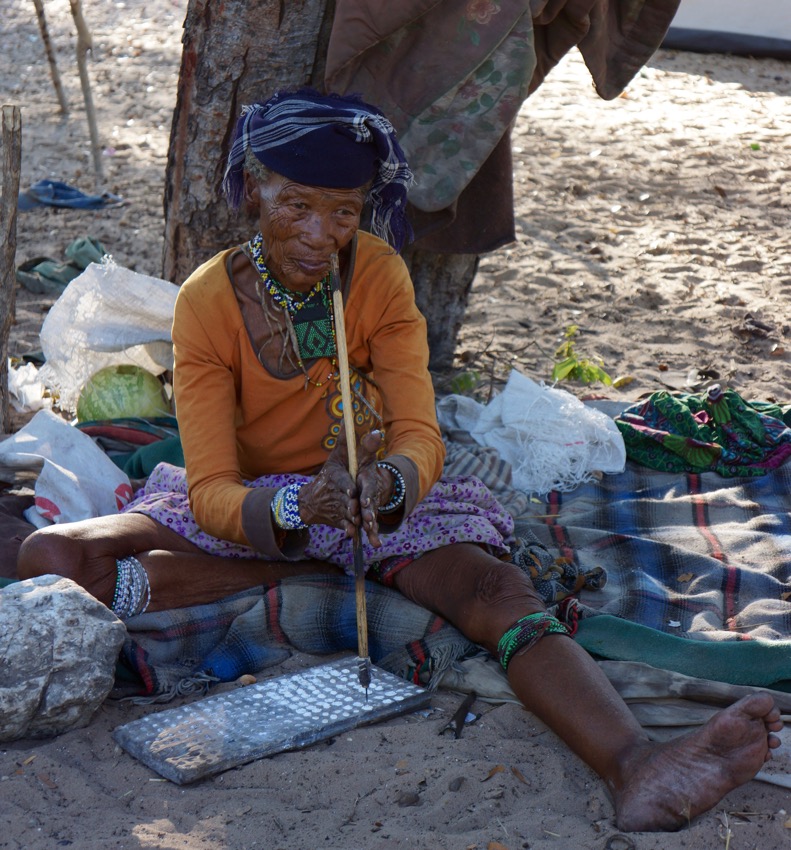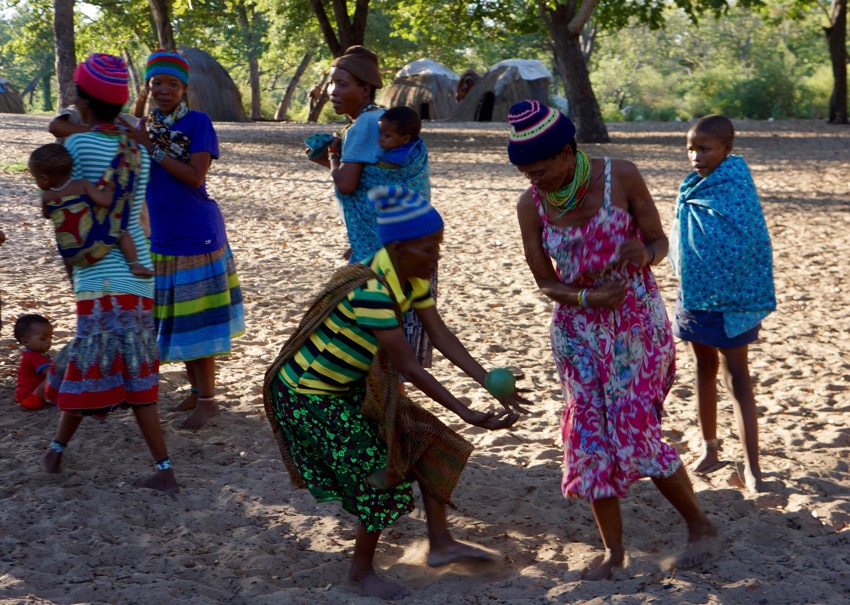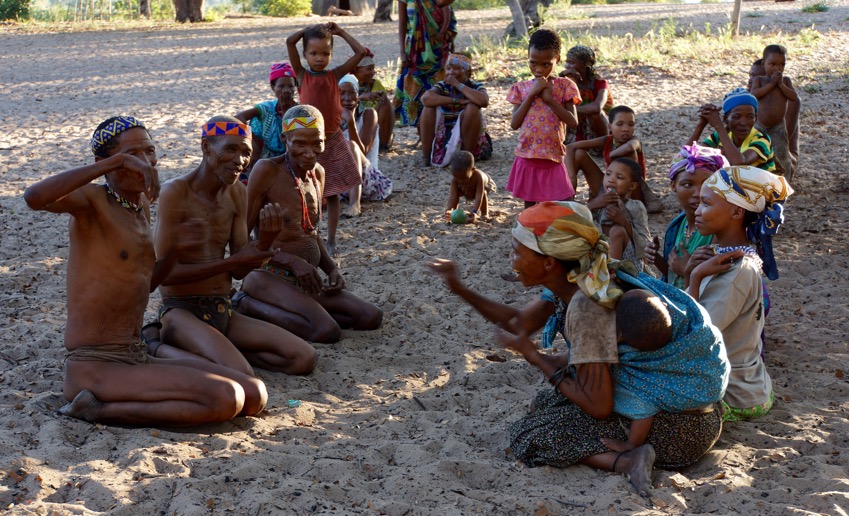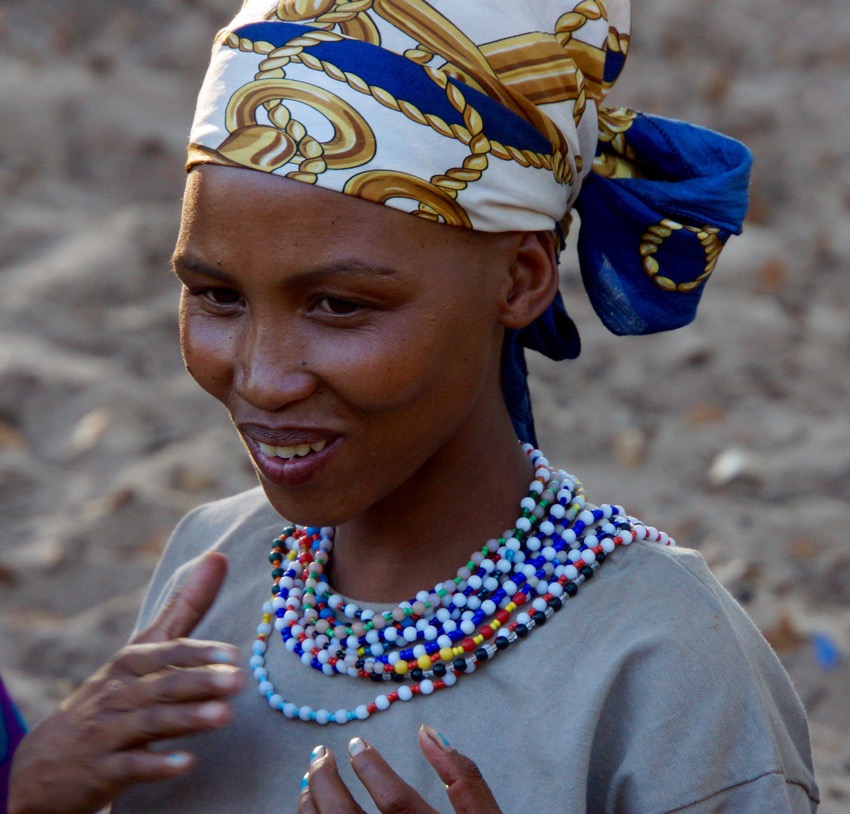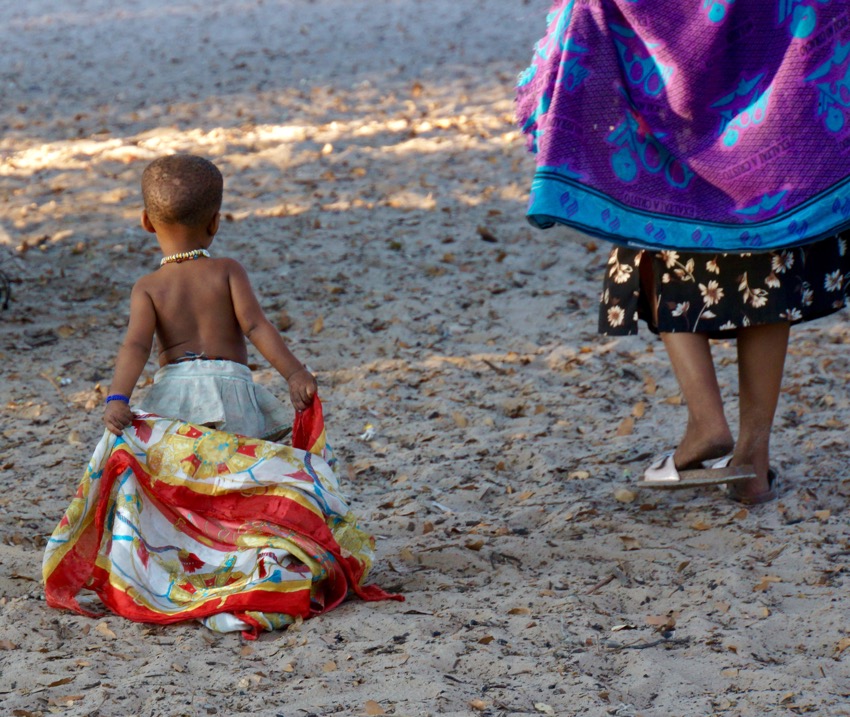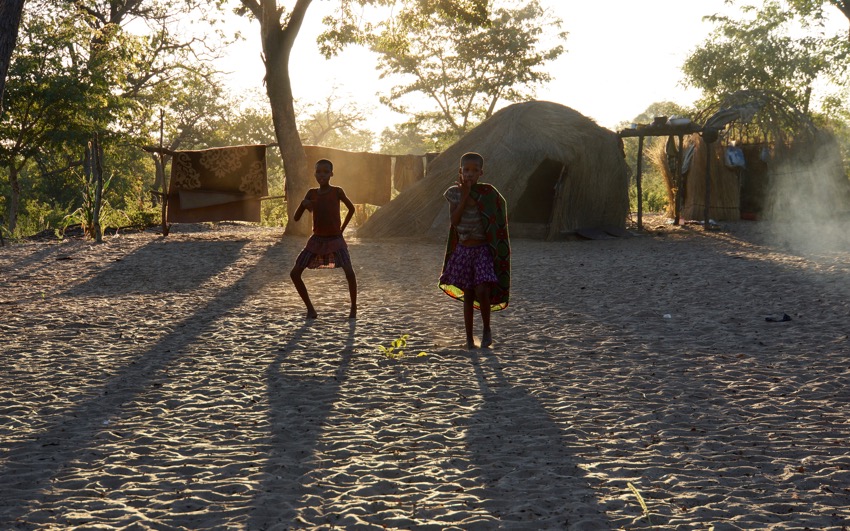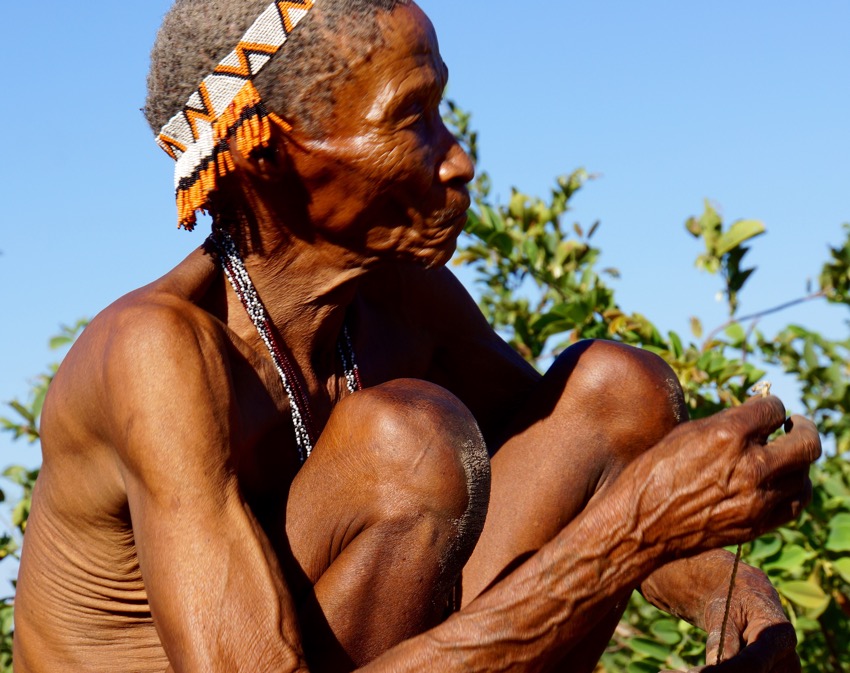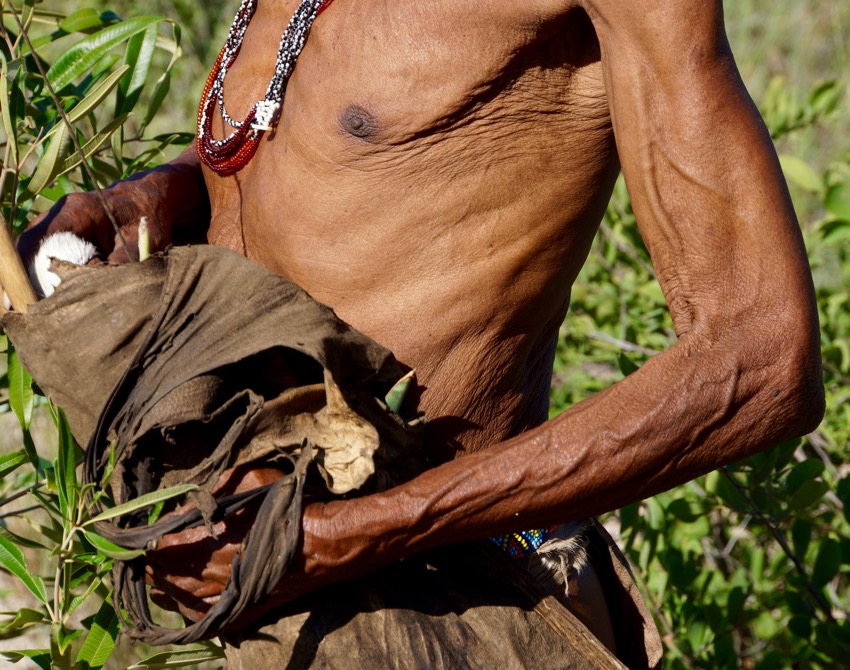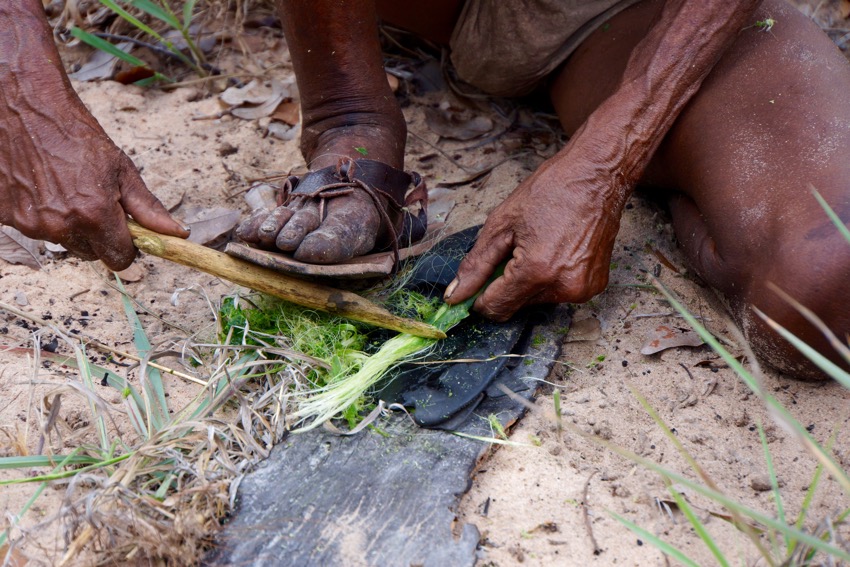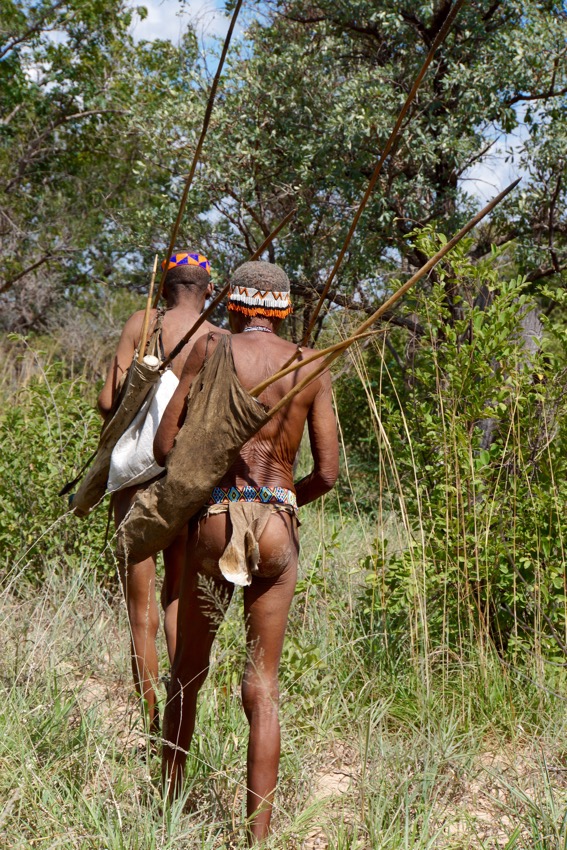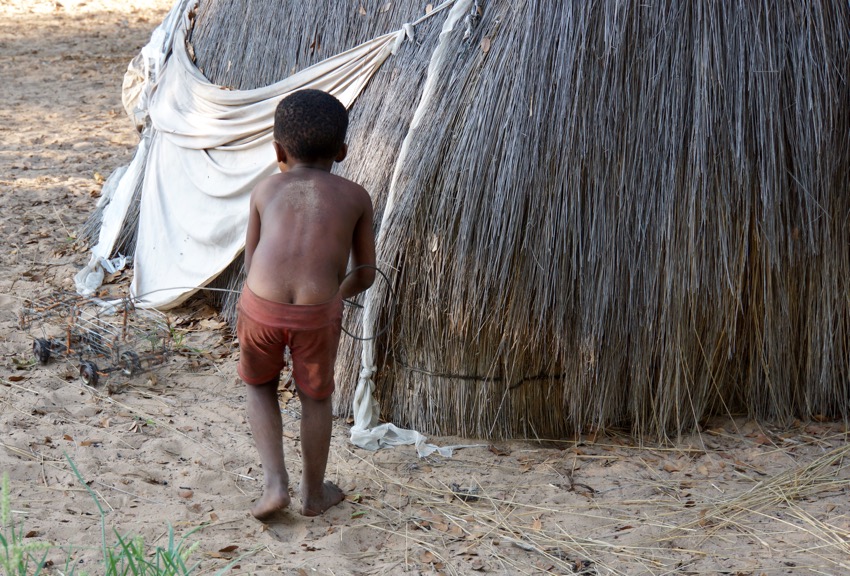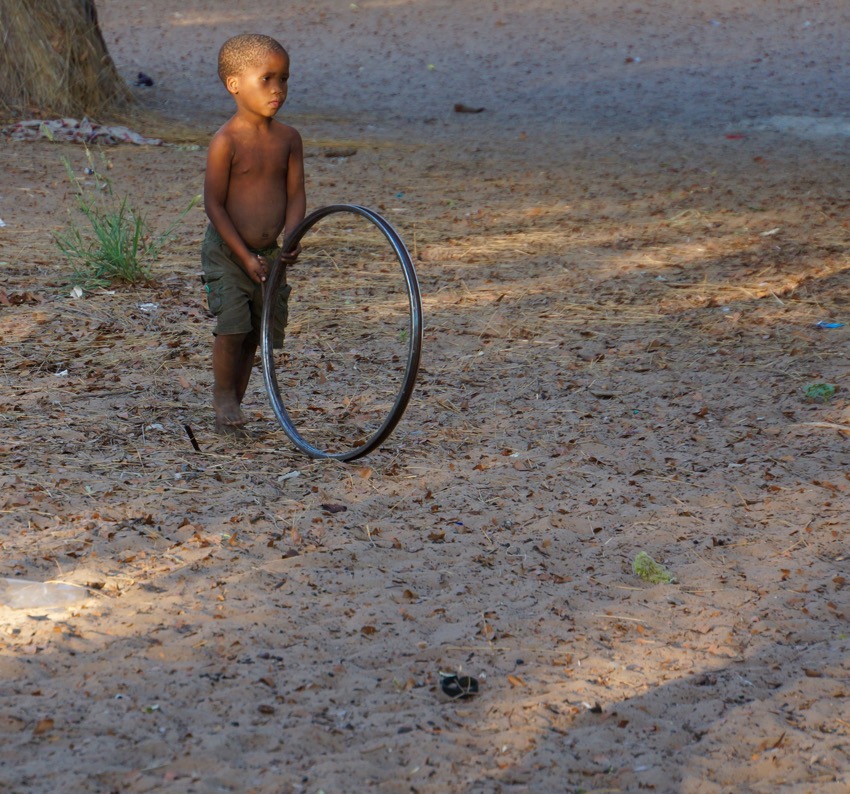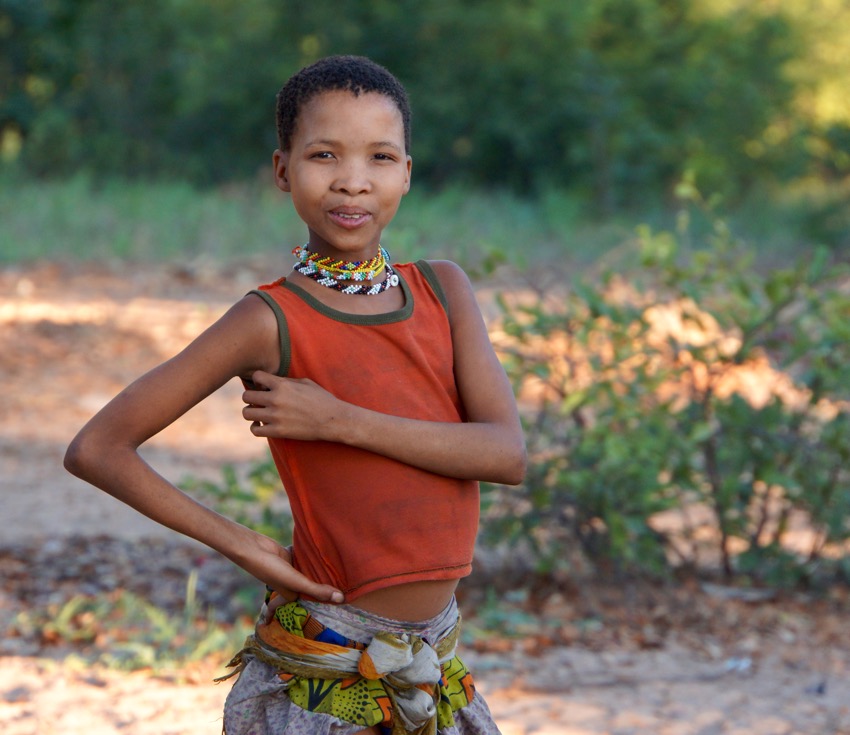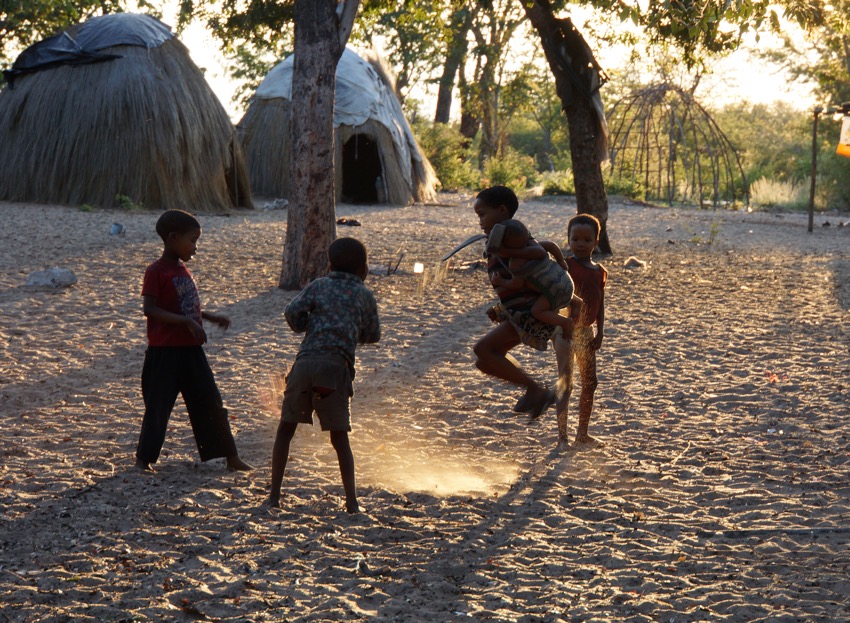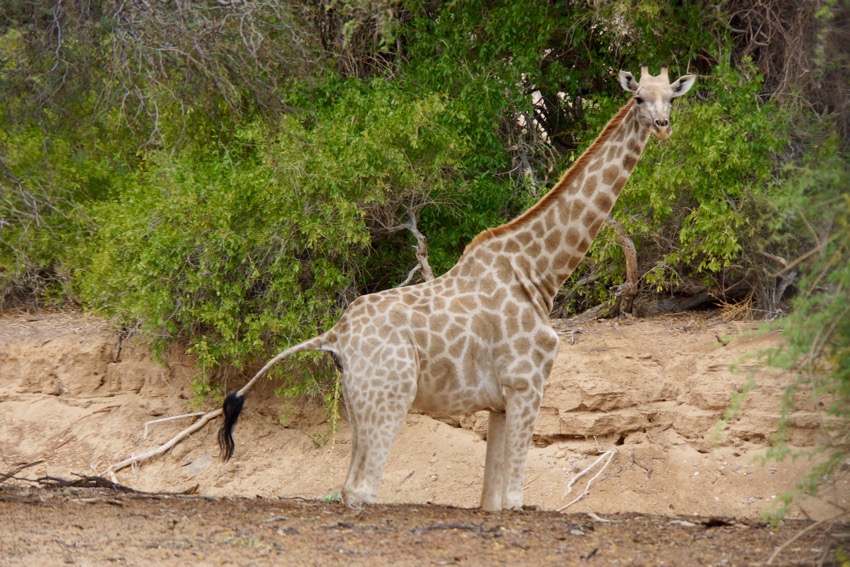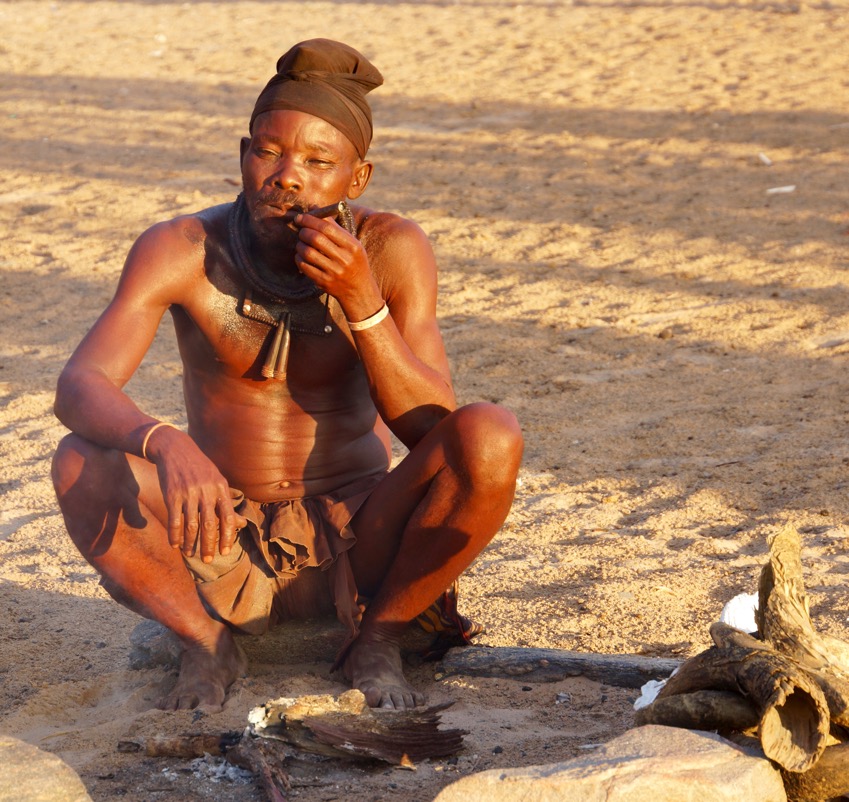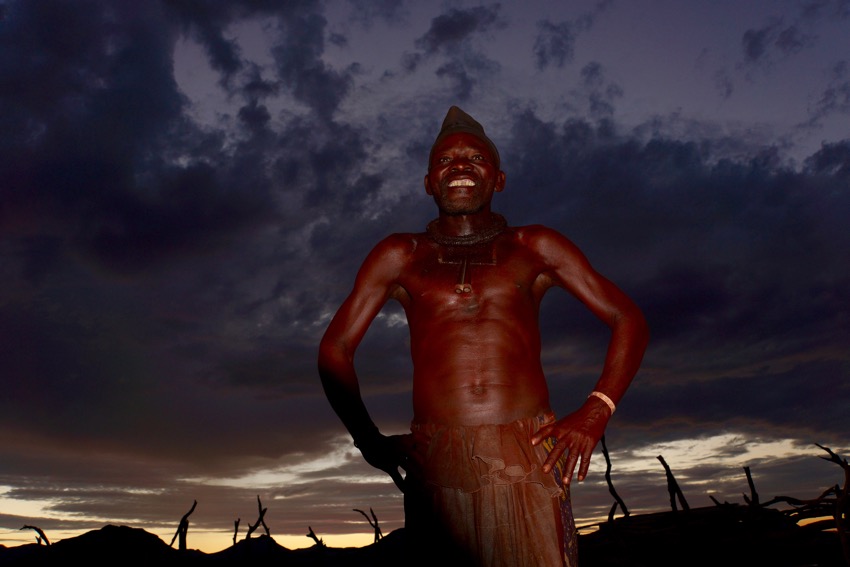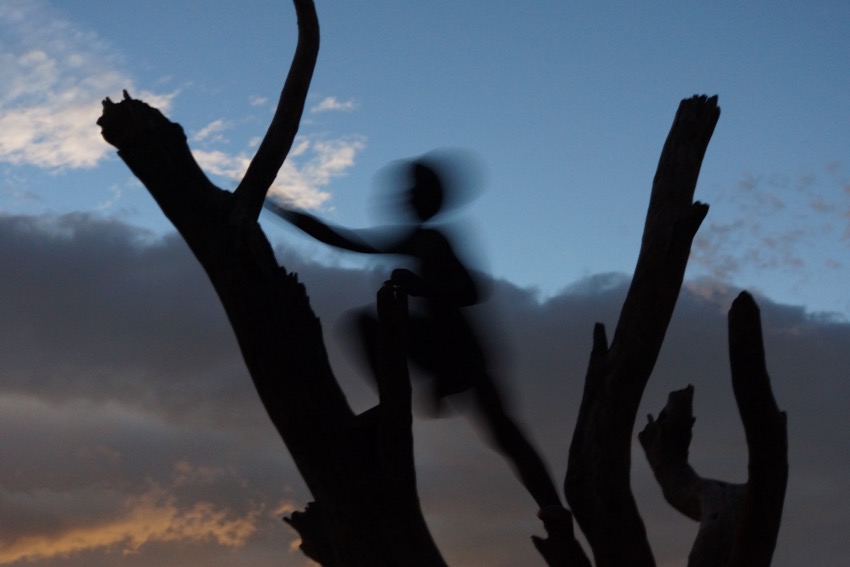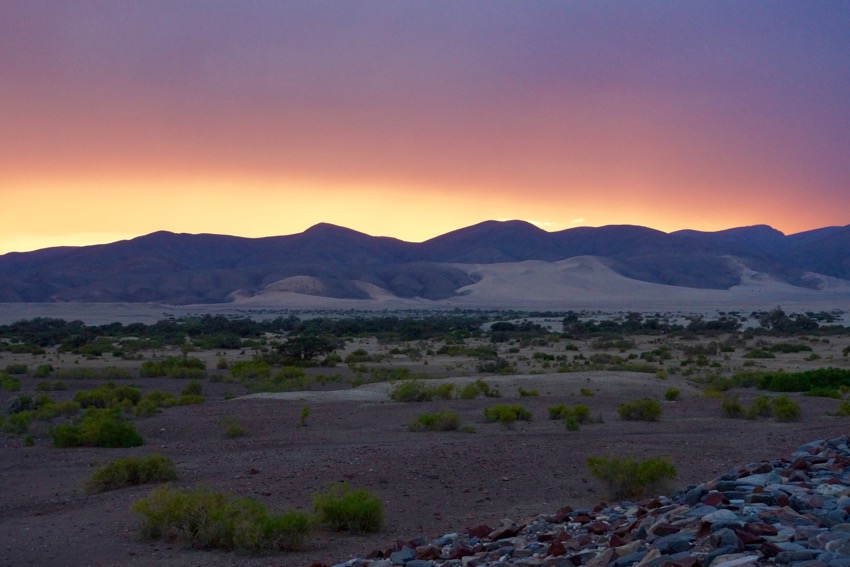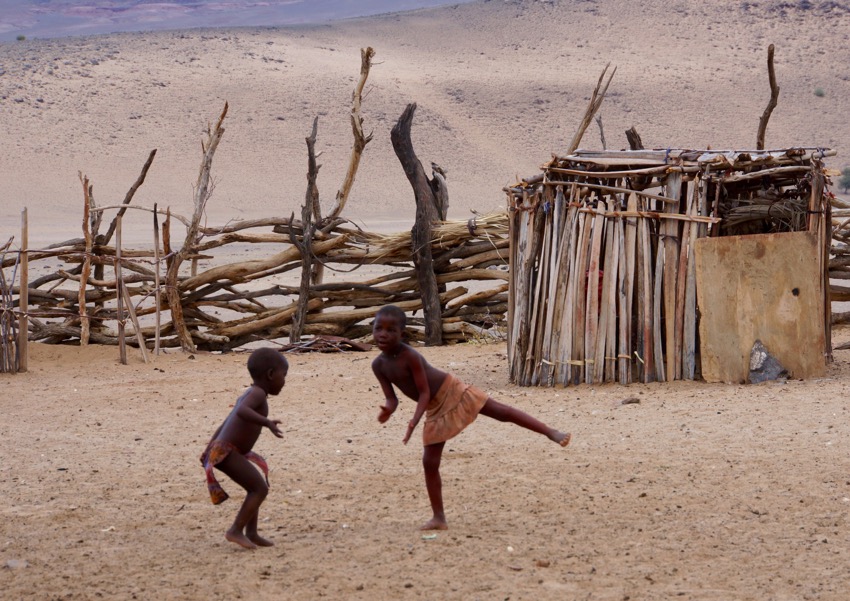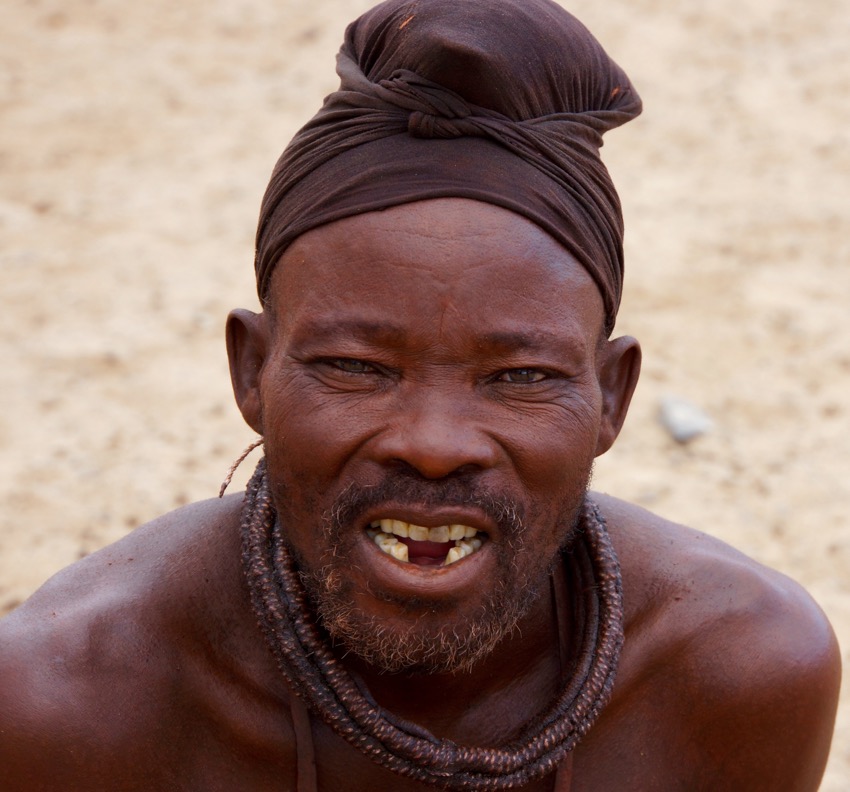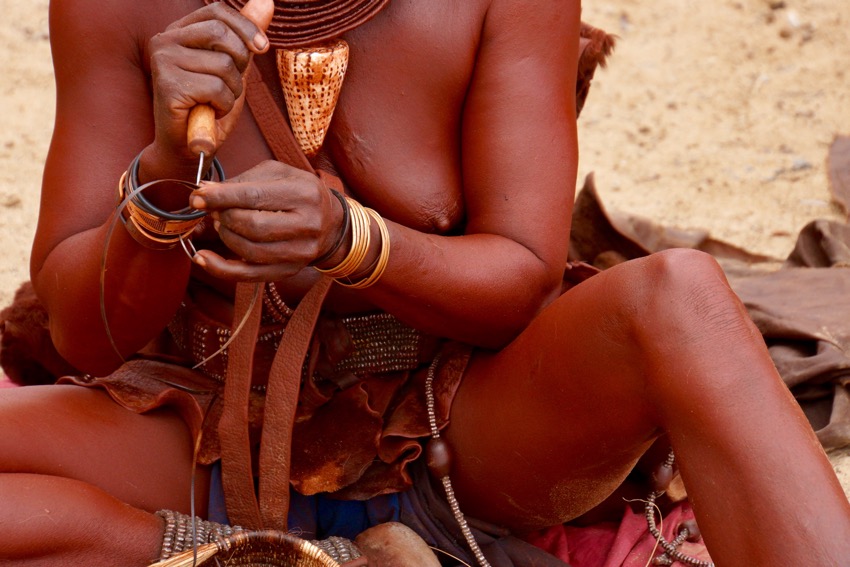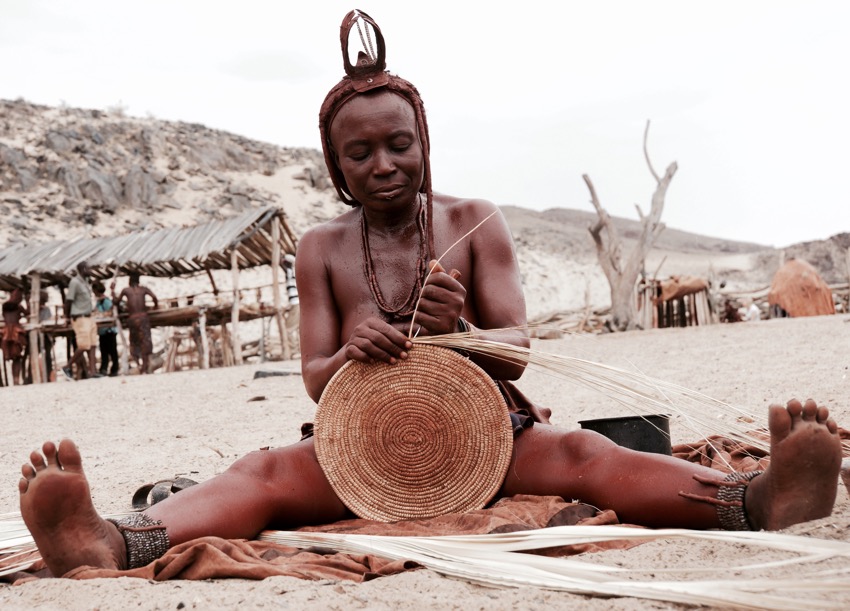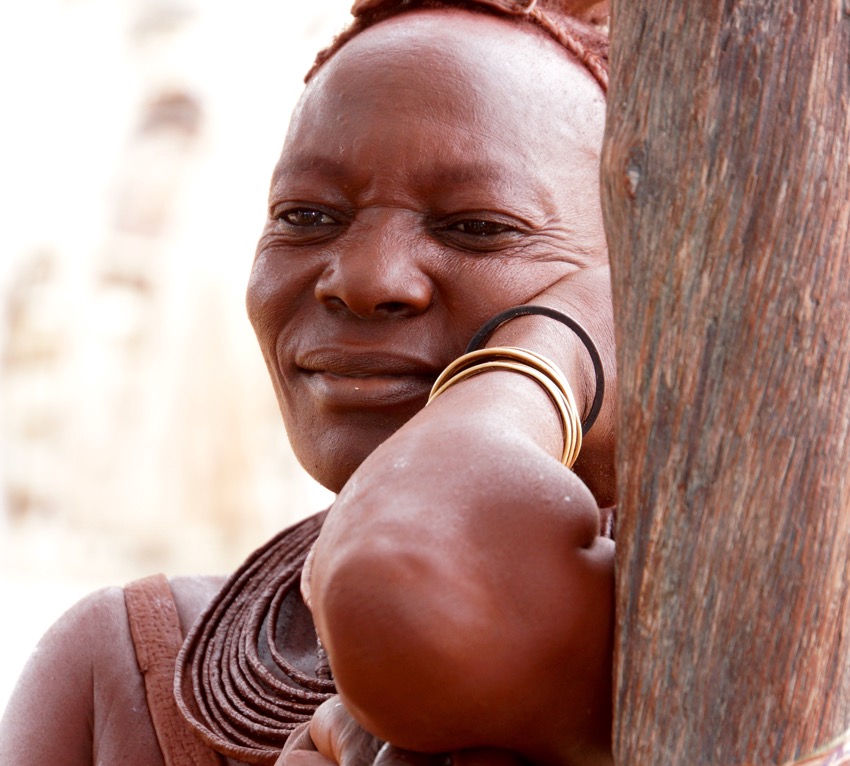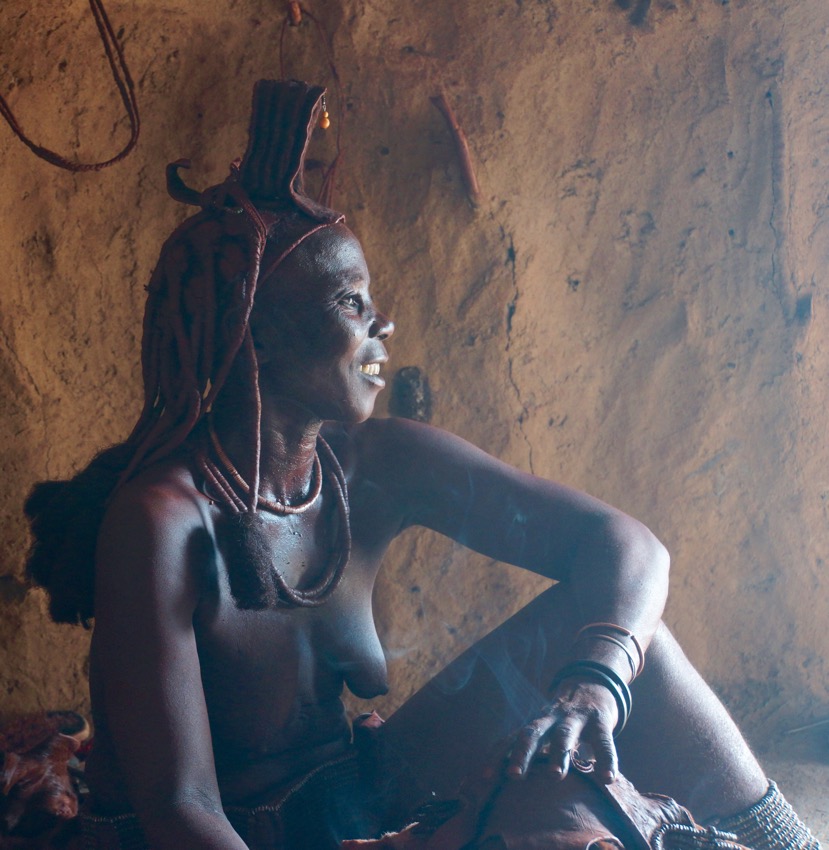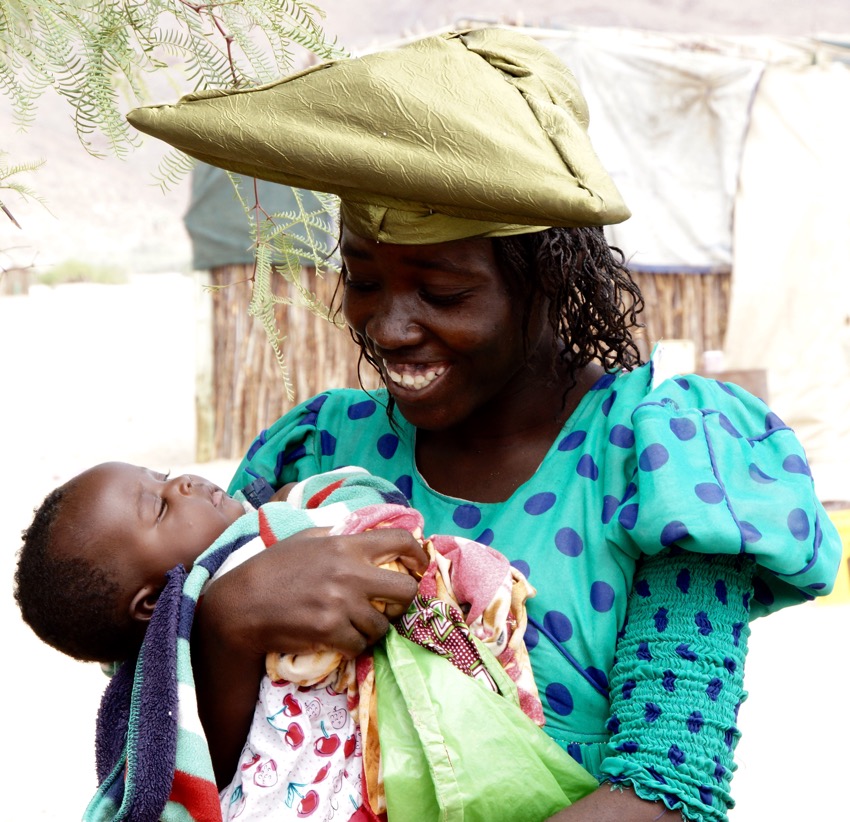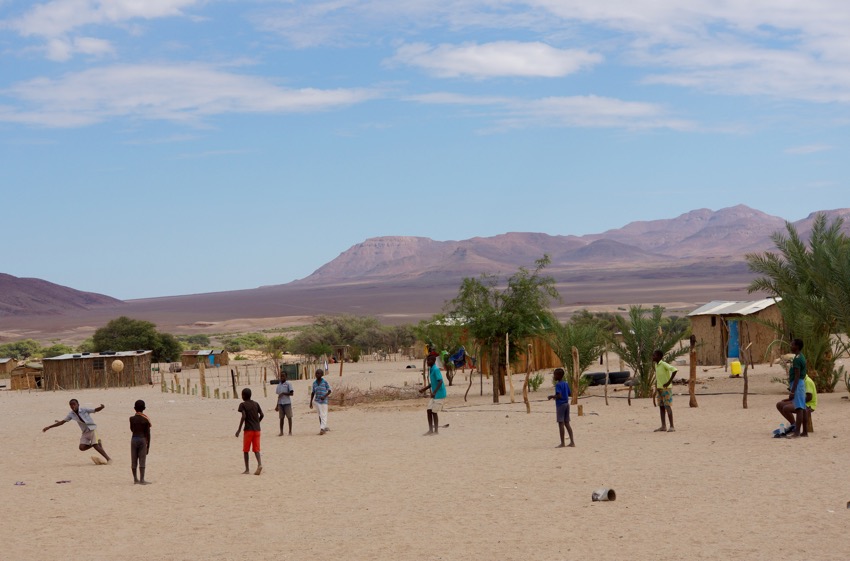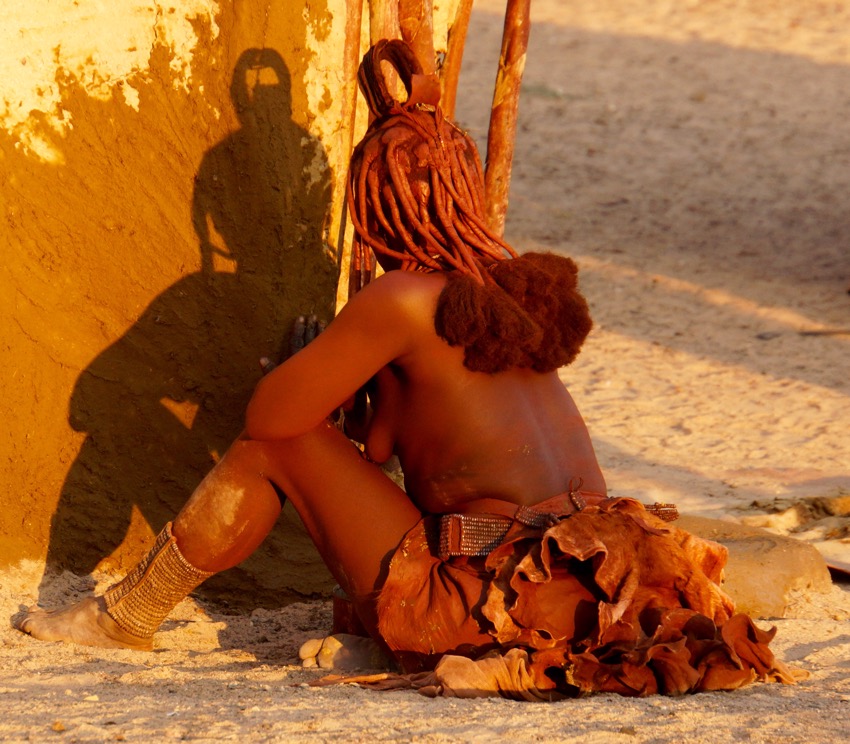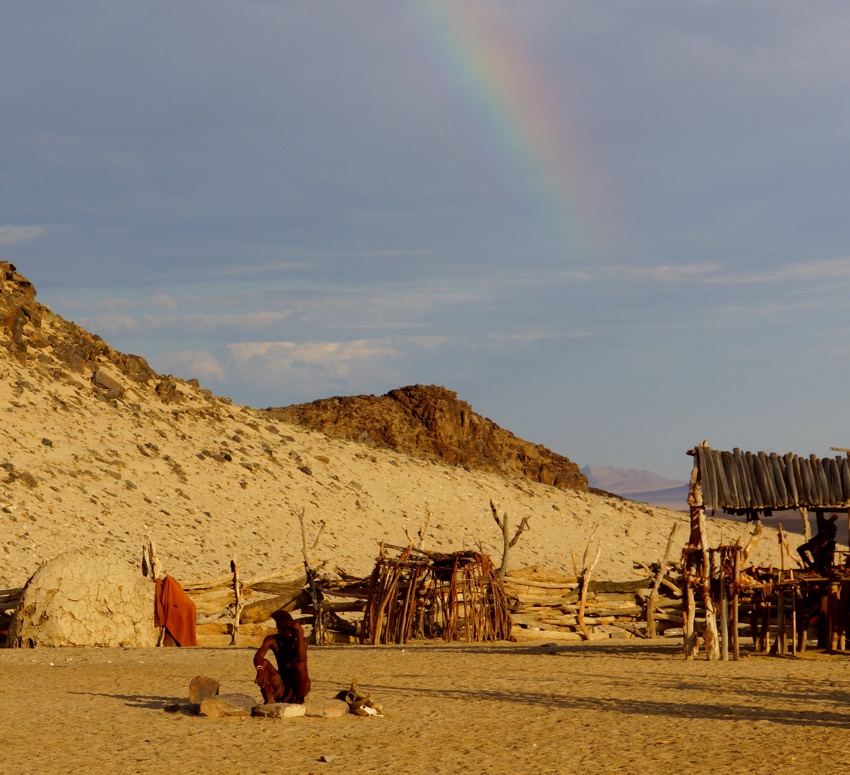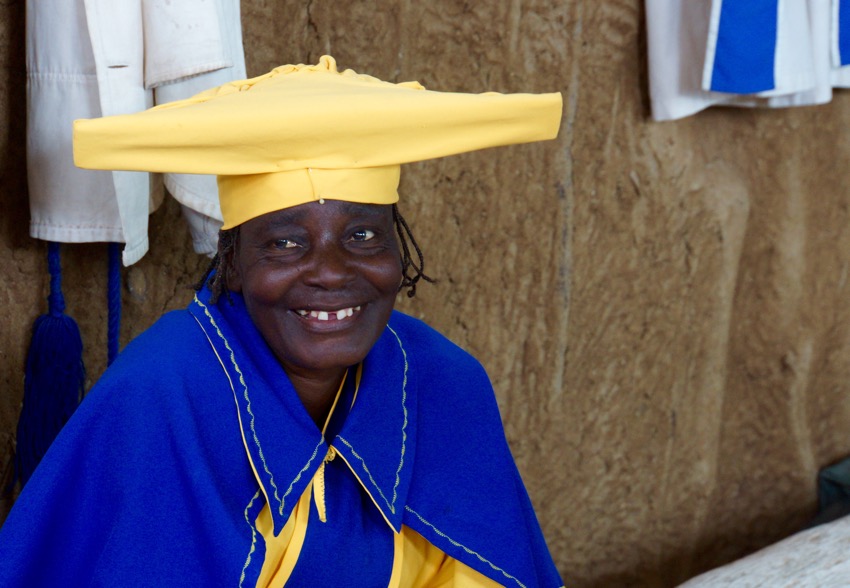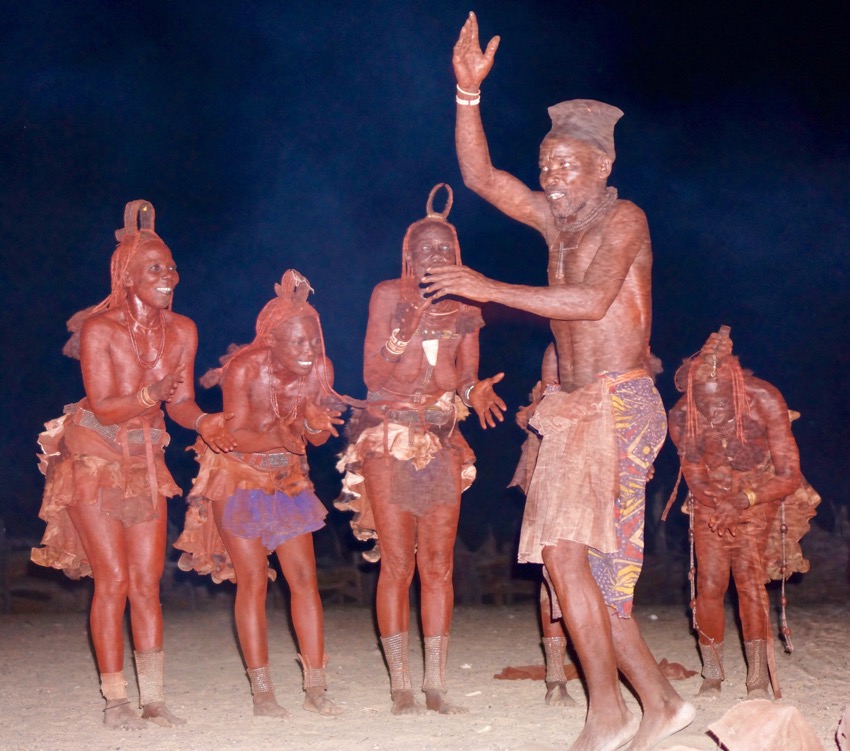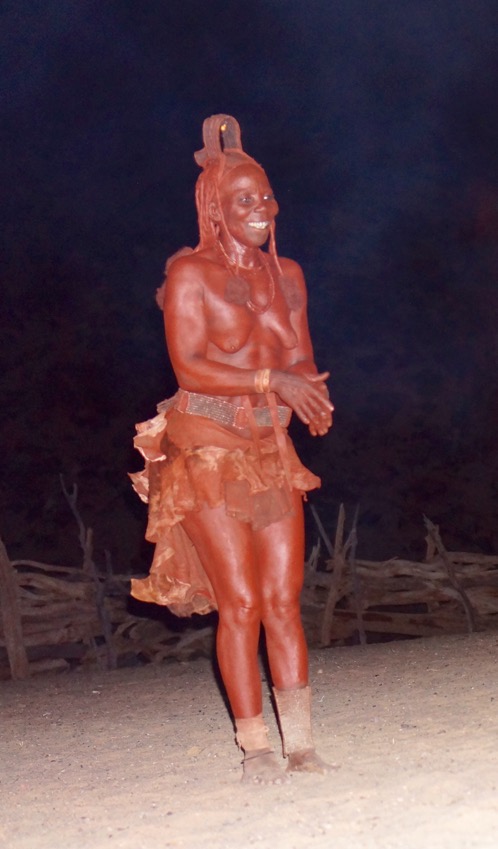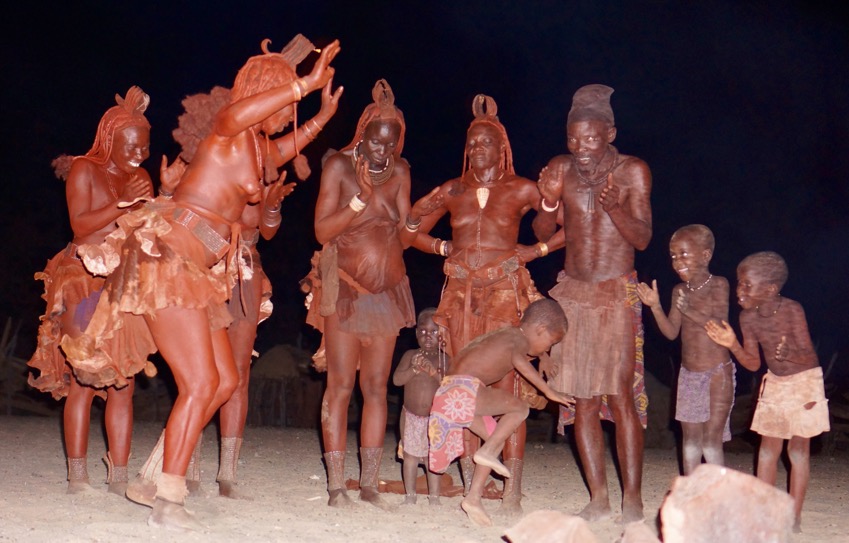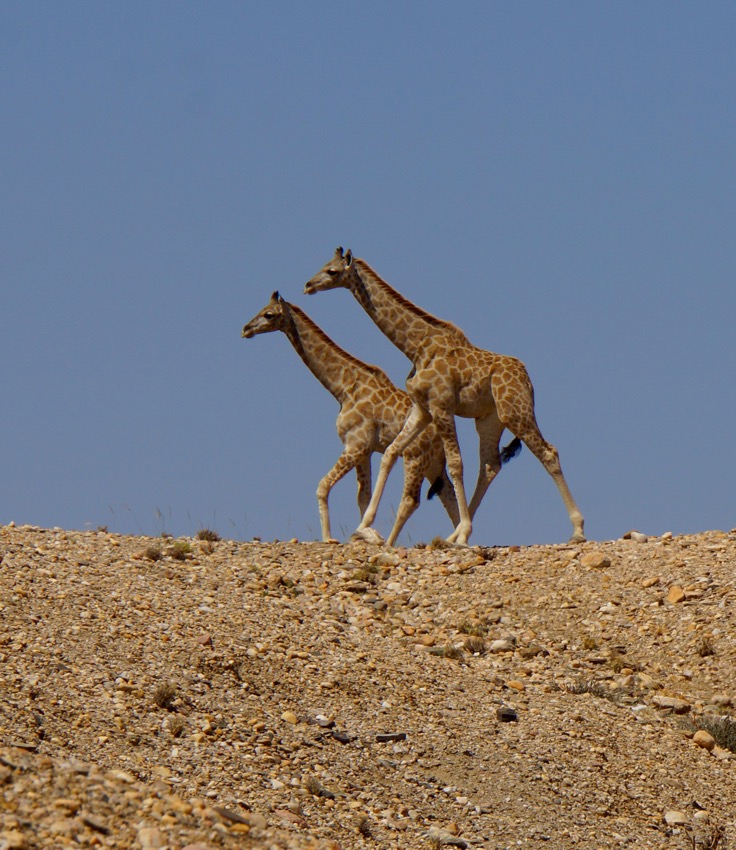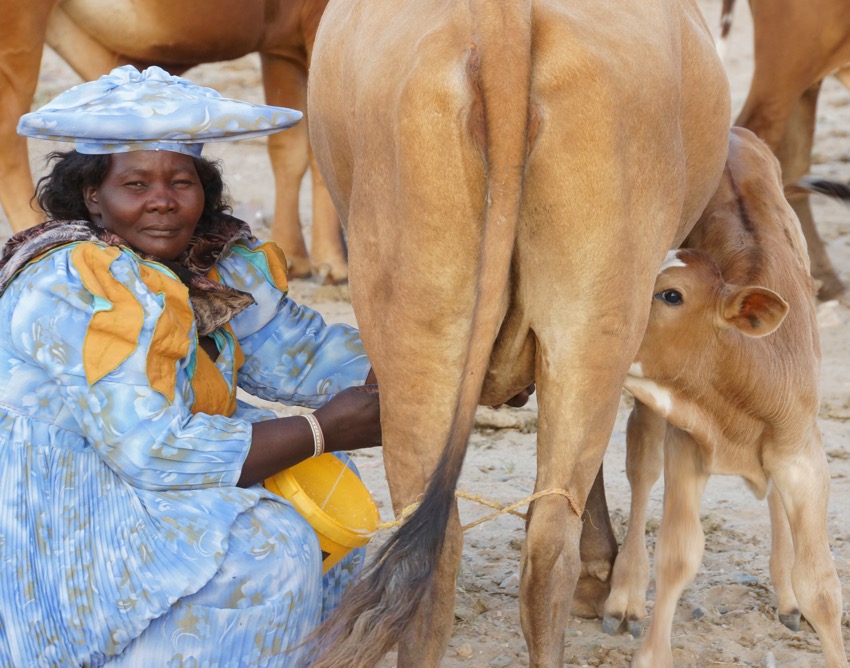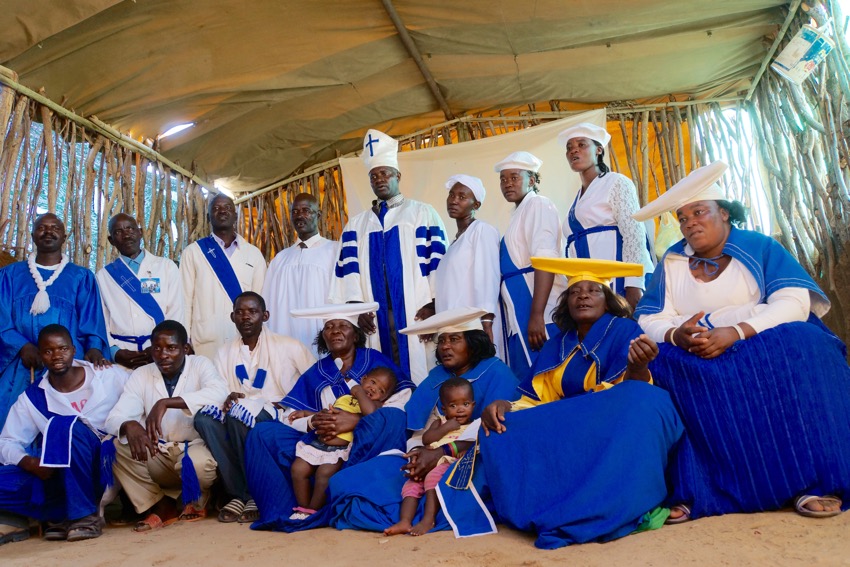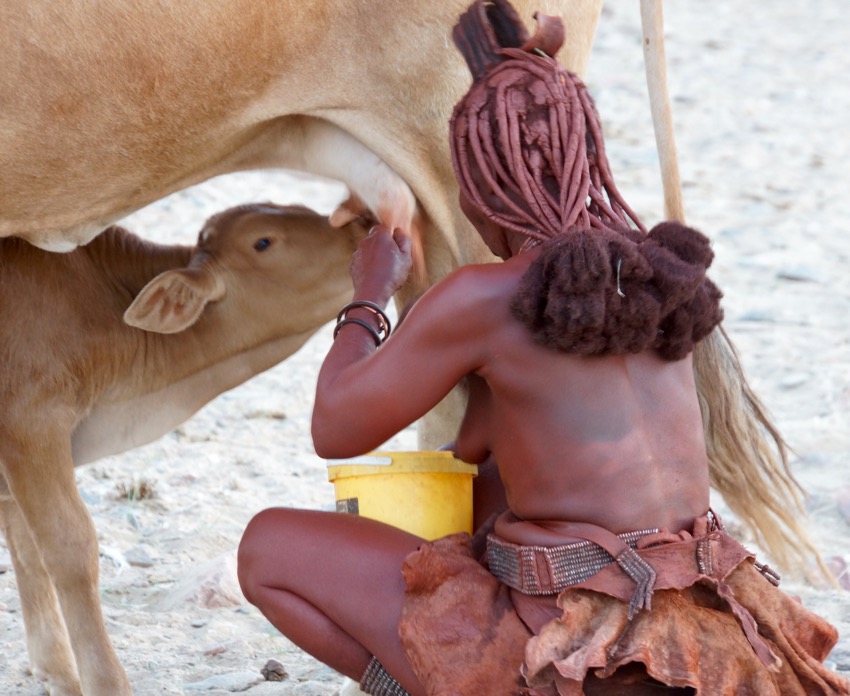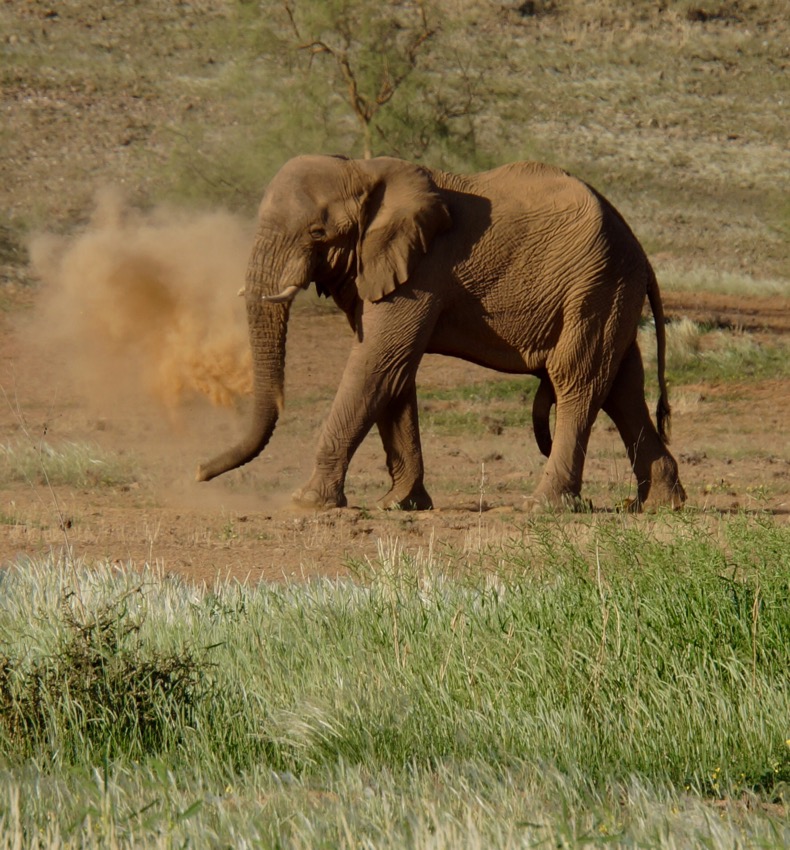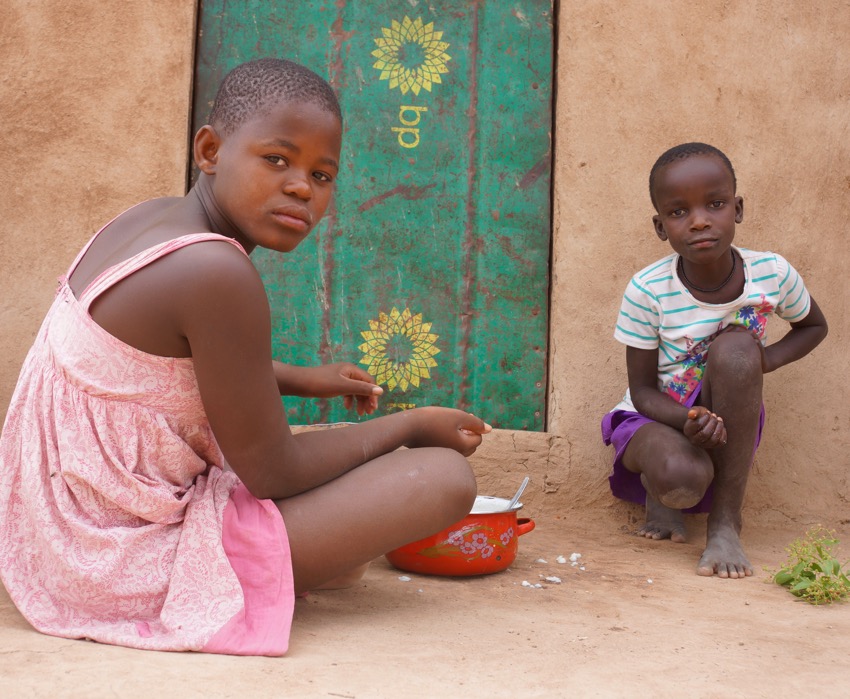April 29. We are a bit sad to be leaving the Mowani Mountain Camp today, because it ranks right near the top of all the places we’ve stayed in the world (and we’ve stayed at some pretty spectacular places). After breakfast at the hotel, we drive to visit the nearby attractions and geological sites of Twyfelfontein rock engravings (recently declared a UNESCO World Heritage Site), Burnt Mountain and the Organ Pipes.
Twyfelfontein: Strewn over a hillside among flat-topped mountains of red sandstone, Twyfelfontein’s boulders and slabs of red sandstone hold some 2,500 prehistoric engravings that depict wildlife, animal spoor and abstract motifs. It is perhaps the largest and finest collection of petroglyphs in Africa. The engravings show animals such as elephant, giraffe, kudu, lion, rhinoceros, springbok, zebra, and ostrich that once used to drink from a spring at the bottom of the hill. In some cases footprints were engraved instead of hooves or paws. The abstract motifs feature mainly circles. Stone tools and other artifacts found at Twyfelfontein suggest that hunter-gatherers occupied the site over a period of perhaps 7,000 years. These days a local guide accompanies visitors to visit the rock art. The engravings lie along two circular routes, one an hour’s climb and the other 40 minutes longer. Twyfelfontein is one of Namibia’s key National Monuments and has recently become a UNESCO World Heritage Site. Because my knee has bothered me off and on, I decide not to do the full climb, but got enough of a taste to satisfy me. Carol did the full hike, and enjoyed it.
Organ Pipes: The Organ Pipes are another geological curiosity in the area consisting of a mass of perpendicular dolerite columns that intruded the surrounding rocks also about 125 million years ago and have been exposed in a ravine due to river erosion.
We then drive south via the Herero markets near the town of Uis on the way to Swakopmund. We stop along the way for a picnic lunch, to see a chameleon one of the guides spotted along the way and to walk on the beach and photograph a shipwreck, arriving in Swakopmund around 5PM.
Swakopmund resembles a small, German coastal resort nestled between the desert and the sea. It boasts a charming combination of German colonial architecture blended with good hotels, shops, restaurants, museums, craft centers, galleries and cafés. Swakopmund had its beginnings as a landing station in 1892 when the German Reich erected the first building, a barracks for troops on the site. The advent of World War I halted developments and the town sank into decline until half a century later when infrastructures improved and an asphalt road opened between Windhoek and Swakopmund..
A timeless classic forming part of Swakopmund’s architectural culture is the grand Hansa Hotel, dating back to 1905. Conveniently located in the center of town, the Hansa Hotel is within easy walking distance to the waterfront, shops, cafes, the aquarium, Crystal Gallery and other attractions. Carol and I have a lovely suite at the hotel. After acouple hours of relaxing/showering/email/blogging, we walk to a seafood restaurant housed in an old boat. Dinner is okay, but not up to the level of what we’ve been getting. And the same might be said of the overall day. But the not every day can be fabulous.
We are told that we probably will not have wifi for the next three days, so there will be a bit of a drought on the blog.
April 27. After an early breakfast, we continue on in our safari vehicles, heading south and east into the diverse region of Damaraland. Along the very bumpy ride, we sight giraffes, oryx, baboons, ostriches, springboks and many bird species.
En route we stop at a small village where Nevada delivers photos she took last year, and we have an opportunity to photograph some Herero women and children.
Damaraland is typified by displays of color, magnificent table topped mountains, rock formations and bizarre-looking vegetation. The present day landscape has been formed by the erosion of wind, water and geological forces which have formed rolling hills, dunes, gravel plains and ancient river terraces. It is the variety and loneliness of the area as well as the scenic splendor that is truly lovely. This is a riveting and long day spent traveling through some of Namibia’s most remote areas. We take our time enjoying stops along the way, including a picnic lunch out of the hot sun, under the shade of a tree. In the afternoon, we pass a fence that stretches west to east across Southern Africa to prevent diseased beef from the north to get into the south. We stop several times to photograph the spectacular landscape, then late in the afternoon we spot an elephant and stop to observe it for a long while. We arrive at our unique camp just after sunset, having spent 10 1/2 hours on the road.
Mowani Mountain Camp is ideally located a short drive from the local attractions in the area. The Camp is nestled among giant granite boulders, overlooking the ephemeral Aba Huab riverbed where desert adapted elephants often traverse. The thatch dome-shape structures echo the shape of the rough textured surrounding granite boulders, a theme complemented by African woodcarvings and artifacts. We are in luxury East African style en-suite tents built on raised wooden platforms, each with a private verandah and splendid views over the Aba Huab valley. This is one beat place, and Carol and I agree that it’s much more to our taste than the elephant lodge we came from (though that was not too shabby, either).
A shower after the long day’s drive feels very good. After that, we wander up for drinks by an open fire and dinner in the main dining room.
April 26. We awake early for breakfast and an early morning game drive that allows us to experience the stark contrast between the river and the barren desert landscape and mountains that abut it. The game sighted includes more giraffes, oryx, ostriches, baboons and many species of birds. Compared to game viewing we’ve done elsewhere in Africa, this was unexceptional, but worthwhile as a way of seeing the area. We do not see either desert elephants or rhinos, which would have made the drive more exciting.
Back to the lodge for lunch and, for some (not us) swimming. Nevada spends half an hour with me reviewing and commenting on some of my images, which is very useful to me. Her comments are frank, constructive, but generous in recognizing good qualities of some of my images.
We head back to the church in Puros, as Nevada had promised the clergyman (who we learn is referred to as the bishop) yesterday. Church services had ended three hours before we arrive, so I was very skeptical that anyone would be there. But I was very wrong, as a full entourage awaits us dressed in full regalia. The bishop asks Nevada to offer a blessing to all, which, after being a bit thrown by the request, she does very well. The bishop then offers his own blessing and then the church group sings a song for us in perfect harmony, akin to the South African music that Paul Simon recorded many years ago. At our request, they oblige us with another song. The bishop’s real agenda is fulfilled when first Nevada and then the rest of us take photos of the group (including a mother nursing her baby) both inside and outside the church.
We drive from there to a place where the Hinba cattle are being kept. They are herded in shortly after we arrive. Two Herero and one Hinba woman, each in native costume milk cows, shooing away calves who want to nurse while there mothers are being milked. After many photos and fond goodbyes, we depart for the drive to the lodge, where after more than a half hour of drinks, we are treated to another excellent dinner. We retire to prepare for tomorrow’s early departure.
I’ve suggested to everyone in the group, and they’ve agreed, that we come up with a group gift to the church. Our guide, Terry, will collect the money and rather than give them cash, acquire something that will help with the new church they are building.
Tomorrow we will be traveling to an area that we’re told will not have internet, so it may be several days before my next post.
April 28. Very early breakfast so that we can leave by 6:30 to look for elephants. We were very fortunate to have seen one yesterday near the highway. Today, we search for them along the river.
Before finding them, we come across a herd of several hundred springboks. They are quite a sight, strewn across a ridge of a mountain, and a great photography opportunity, including taking panoramas.
It takes us three hours of driving to locate the elephants, but we finally do, and have the opportunity to watch a herd of some fifteen elephants, including two babies.
Desert Adapted Elephant: The desert elephants are different from their more usual relatives in terms of their behavior patterns rather than their genetics. It is true that they often have wider feet and are (incorrectly) reputed to have bigger ears because of the environment they live in, but they are definitely not a different species. In habitats with sufficient vegetation and water an adult elephant consumes as much as 300 kg of roughage and 230 liters of water every day of its life. Consider what a herd of them would eat and drink in a week or a month or a year. Finding an African elephant in a desert? Well, yes…and not only elephant, but other large mammals as well, such as black rhinoceros and giraffe. Their ranges extend from river catchments in northern Kaokoveld as far south as the northern Namib. Apart from the Kunene River, seven river courses northwards from the Ugab provide them with possible routes across the desert, right to the Skeleton Coast. The biggest are the Hoarusib, the Hoanib, the Huab and the Ugab Rivers.
Desert adapted elephants in Kaokoland and the Namib walk further for water and fodder than any other elephant in Africa. The distances between waterholes and feeding grounds can be as great as 68 km. The typical home range of a family herd is larger than 2,000 km, or eight times as big as ranges in central Africa where rainfall is much higher. They walk and feed at night and rest during the day. To meet their nutritional and bulk requirements they browse on no fewer than 74 of the 103 plant species that grow in their range. Not a separate species or even a subspecies, they are an ecotype unique to Namibia in Africa south of the equator, behaviorally adapted to hyper-arid conditions. Elephant in Mali on the southwestern fringe of the Sahara Desert are the only others known to survive in similar conditions.
After having our fill of the elephants, We visit the interesting Damara Living Museum to learn about the traditional customs of the early inhabitants of Namibia. We are shown around to various areas, Williamsburg style, to see black smithing, pharmacy, crafts and singing and dancing. It was rather well done.
We return to the lodge for an excellent lunch and a short rest. Carol decides to pass on the afternoon activities, but I go about an hour with the group to see De Riet village. The people living here are mostly Rimvasmaakers who are Damara/Nama speaking people who were resettled into the area from the Northern Cape by the South African Government in the days when people were moved to tribal homelands on a relatively arbitrary basis of being in the same language group. Many of them moved back after Independence, but those who are left offer a interesting insight into a different lifestyle adapted to the harsh environment. One of the elder ladies gives us a story of being removed from South Africa, then after Mandela, being given the opportunity to go back, which many of them declined.
It’s always interesting to hear the things that people we visit are concerned about and to reflect on how everyone has problems, some of which are the same and some different. For example, the concerns in the village about elephants and jackets are not our concerns, but on the way back to the lodge, we discussed Namibian governmental problems with two of our guides, Stuart and Usko,, and those did not sound so very different than ours–health care, unemployment and land (by the latter was meant the desire of younger Namibians to own land, which is held very disproportionately by whites, Germans and South Africans). On the way back to the lodge, Stuart brought the van to a sudden halt. Crossing the road in our path he’d spotted an 8-foot python. We got out to photograph it, and Nevada actually touched it.
Short time in the room before drinks and another really excellent dinner at the lodge. We have eaten very, very well on this trip.
|
|
